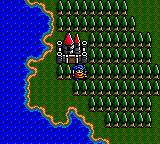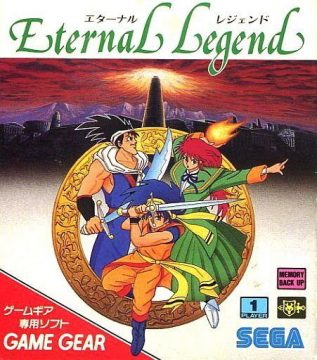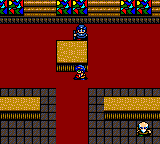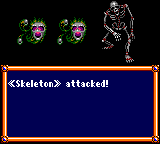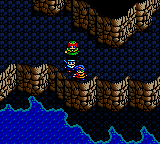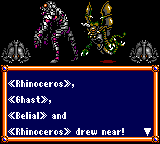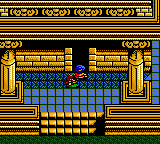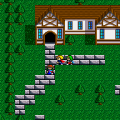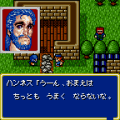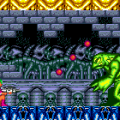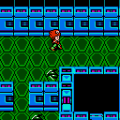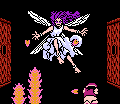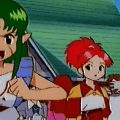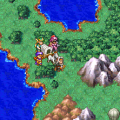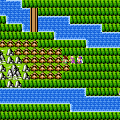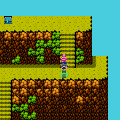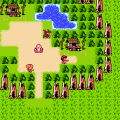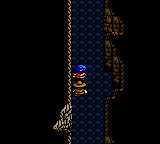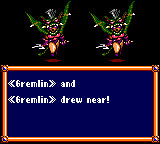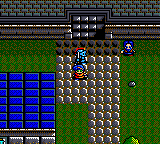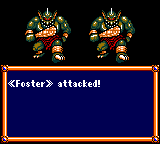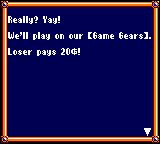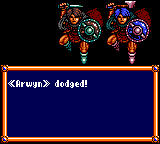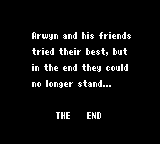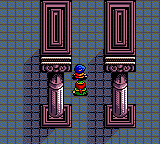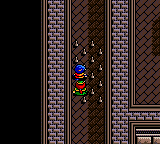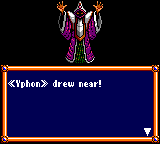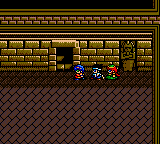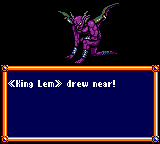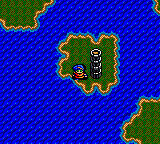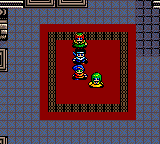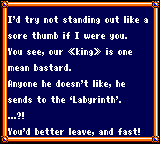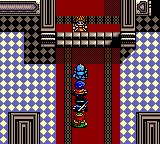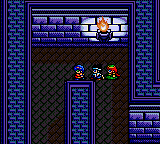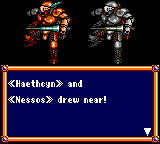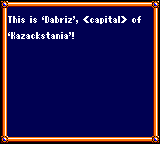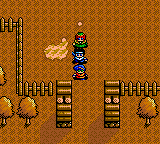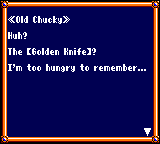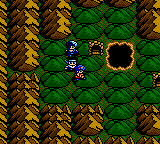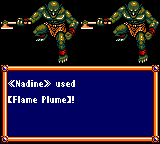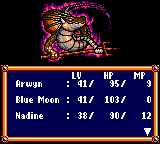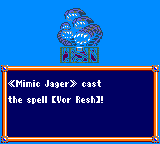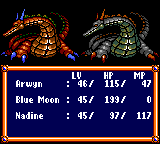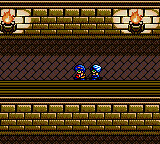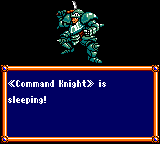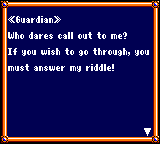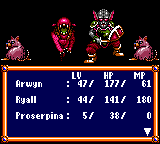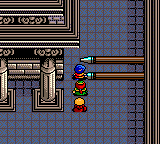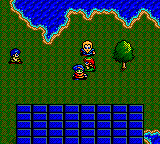During the late 1980s into 1990, Dragon Quest’s first four entries had taken Japan by storm, making RPGs the hot trend for developers and publishers to follow. Portable consoles like the Game Boy would naturally benefit from capitalizing on this, which led to games like Makai Toushi SaGa, Sword of Hope, and Ayakashi no Shiro arriving during the Game Boy’s early years. Sega got into the portable business a bit later than Nintendo, but it only took until October 1991 – less than a year after launch – to get a RPG on the Game Gear in the form of Eternal Legend, courtesy of Japan Art Media. While only debatably the first RPG on the Game Gear (depending on whether you consider Dragon Crystal and Head Buster to be RPGs), it is for certain the first game on the console to be built so firmly on the foundation of Dragon Quest. Japan Art Media had proven themselves capable of making an interesting spin on the Dragon Quest formula with Aretha, but Eternal Legend is a regression, losing much of what made Aretha stand out while incorporating a lot of questionable design choices. It was a game with a valuable niche at the time, but one that struggles to remain memorable or desirable in the modern day.
While Eternal Legend was exclusive to Japan, a translation was released by LIPEMCO! Translations in May 2020, exposing the rest of the world to this footnote in RPG history. Little about Eternal Legend is known outside of Japan. In an attempt to make it palatable to modern gamers, cheats were inserted into the translation, allowing for faster movement and the ability to disable encounters at will. Both options are immensely useful, since movement is dreadfully slow and the encounter rate is exactly as high as you’d expect, but it’s telling that every English resource available implores you to use cheats to make the game bearable in the first place.
The story begins with a budding treasure hunter named Arwyn arriving at the town of Hark with his mentor Barth, a man clad in a brown getup and hat resembling the likes of Indiana Jones. The two go on an expedition to the nearby cave, but it goes horribly wrong, resulting in Barth’s demise. With his dying words, Barth asks Arwyn to find the mythical golden city of Millennium (clearly inspired by El Dorado) with the help of a man named Thoron and gives him a mysterious golden knife. During his quest, Arwyn teams up with Ryall, an amnesiac girl versed in magic, and a brash swordsman known as Blue Moon, and the three get entangled with the villainous Gaura Empire, which seeks both Ryall and the golden knives for its nefarious purposes.
The specific flavor of treasure hunting adventures made iconic by Indiana Jones is a rarity amongst Japanese RPGs, but Eternal Legend fumbles the execution. Once it’s revealed that the team needs to find eight golden knives to access Millennium, the rest of the game essentially becomes a large fetch quest with very little of interest in between. The vast majority of the game is spent moving from town to town, oftentimes ones you’ve already been to, in order to find the one NPC that has the info you need. In the grand scheme of things, dungeons are usually more in service of moving the plot along than they are about indulging your curiosity. Seven of the eight golden knives are simply given to you by a NPC or as a boss reward, and the plot ends up focusing more on the conflict with the Gaura Empire than anything else, culminating in a finale that feels disappointingly in line with conventional genre stories.
Much like Final Fantasy II, the playable cast rotates frequently to suit the plot, introducing you to characters like Foster, the knight for hire with a secret identity, the mysterious Nadine who assists you when a plague takes Ryall out of commission, and Proserpina, a young girl with the ability to turn into a dragon. While this idea isn’t handled entirely well- since it’s possible to lose a disastrous amount of items whenever someone leaves- it oftentimes supplies the game with its most interesting scenarios. It’s through these characters and their story vignettes that the game teases the potential of deeper themes, such as dealing with loss, the burden of succession, and the cycle of revenge, but perhaps due to budgetary or technical limitations, none of these themes pan out in any meaningful way.
Any potential intrigue within the story is marred by an unfortunately dismal presentation, even for the platform and time. Dialogue isn’t presented on the same screen as the world itself, but rather on a blue background with simplistic white text. There are never any animations or character portraits as a result of this approach and it causes the presentation to feel primitive compared to its competition, failing to utilize the strength of visual storytelling so inherent to video games.
The characters themselves are visually distinct and feature colorful designs, aside from an odd choice to make everyone’s eyes a solid color that results in some creepy looking faces. The music also fails to instill any sense of adventure or wonder, with repetitive tracks containing slow, obnoxious notes that grate on the ears. The game is undeniably grandiose, with a massive world map and runtime that exceeds most of its contemporaries, but the scale is wasted on identical looking towns and bland caves with far too much empty space. Even Millennium itself is a gold-tinted palette swap of a previous dungeon type, so what should feel like an adventure ends up feeling like a repetitive chore instead.
Progression is remarkably obtuse in Eternal Legend, and it oftentimes feels like the game is messing with the player. The very first task of the story has you looking for an invisible pair of glasses, but the best example of the game’s chaotic nature lies in the Labyrinth dungeon. Since you’re stuck there for a while, all of the usual amenities are available, but you need to find them by examining specific walls. You’ll also have to do this to find eight different NPCs, none of which provide useful hints. However, talking to them is the only way to trigger the next step, which involves finding an amulet on a blank tile in a random hallway. Doing this will allow you to fight the cyclops, who can found on a different blank tile in a different random hallway. Once you’ve defeated the boss, the exit still won’t be clear to you. That’s because the exit is behind the door sitting at the back of the dungeon’s pharmacy, of all places, and examining the door earlier doesn’t give any indication of it being different from the unusable doors in the other facilities. How exactly does slaying a cyclops open up a door in a pharmacy, and why would anyone assume that was the answer? The mind boggles.
Combat is as milquetoast as it gets for the genre, offering the usual combination of attack, magic, item, defend, and run commands. Just like the rest of the game, the presentation in combat in minimal to a fault, with every battle taking place on the same black background with no animation whatsoever – attacks are represented with a violent screen shake, and magic spells make the screen intensely flash a color depending on the spell used. Equipment durability is a factor in combat as well, and if a piece of gear breaks, it’ll significantly reduce a character’s effectiveness. The probability of it occurring depends on how strong your opponent is, but it’s still rare enough that it almost never affects the outcome of a fight. Battles are also accompanied by what might be the shortest battle theme in RPG history, which certainly doesn’t help.
Where the mechanics of Eternal Legend become a bit more interesting lies in what happens behind the scenes. Just about every calculation within Eternal Legend has a noticeable degree of variance, whether it’s the damage of an attack or the amount of experience and money earned after a fight. As a result of this, you’ll run into weird surprises like critical hits doing less than normal attacks and groups of enemies dropping fewer rewards than a single enemy. It feels like an attempt to bring the dice-based calculations of Dungeons & Dragons into a console-style RPG, which is novel for the time if nothing else, although its effects do become less noticeable as the numbers grow larger. This variance also applies when characters level up, resulting in drastically randomized stat gains every time. This can be manipulated with plentiful saving and reloading to maximize your characters’ effectiveness, and it’s recommended that you do so to stay ahead of the curve.
Magic is handled strangely in Eternal Legend, with a system where spells are learned as you hit specific intelligence thresholds rather than at specific levels. It’s an interesting idea that meshes well with the constant unpredictability of combat, but it results in a bizarre power curve for Ryall, where for most of the game she’ll have barely any magic, only to get pages of the stuff within a handful of levels later on. Arwyn is the only other main party member to get magic, but this system causes him to go without spells until the end of the game where they’re too outdated to be useful without excessive leveling.
One area where Eternal Legend actually improves upon Aretha is its monster summoning system. In Aretha, summoned monsters were weak and only lasted for one battle, but here they’re usually stronger than your party and are essential against bosses. Throughout the game, you’ll find items that let you summon a monster in battle, which will alternate between attacks and a single magic spell at random. Monsters can’t be controlled, nor can you target them with spells or see their current status, but they come with high HP totals and fully heal after every fight provided they don’t die; if they do perish, you’ll never be able to use them again, making their deployment always carry risk.
Despite its simplicity, Eternal Legend suffers from some exceptionally uneven balance in ways that can work with or against the player. Most notably, the economy is absolutely broken, featuring shops with gear that costs thousands of gold when most fights rarely give you more than a dozen gold until later on. The game attempts to provide a thematically appropriate workaround for this by having most treasure chests contain generous amounts of cash, but even that is never enough. Thus, you’ll oftentimes have to survive without upgrading for several hours. Thankfully, running away is surprisingly reliable, so you can always grind near towns and run away from everything in dungeons to finish them safely. Once you’re strong enough to learn Gimel, the sleep spell, you can crush every encounter from there, since nothing in the game is immune to sleep, including the final boss.
While Eternal Legend is a disappointment compared to Aretha, some of its ideas would end up making it into Aretha II, such as equipment durability and an emphasis on the exploration of massive spaces. Likely due to its specific place in history, the game is remembered fondly by Japanese gamers, resulting in creations like a fan remake in RPG Maker, a Master System conversion hack, and even a rom hack called “Pokemon Legends” that changes Arwyn into Pikachu and Barth into Ash Ketchum. Over a decade after its release, a group of 2ch users were able to discover the existence of hidden items based on the Maneki-neko that are capable of instantly leveling up the party like the Testament in Aretha, ironically providing a mystery more intriguing than Millennium itself.
Links
https://gamegear.jp/eternallegend/ – Page with links (in the comments) to the RPG Maker remake and 2ch thread
https://www.youtube.com/watch?v=YTIzvEGC_F4&feature=youtu.be – Commercial featuring Eternal Legend
